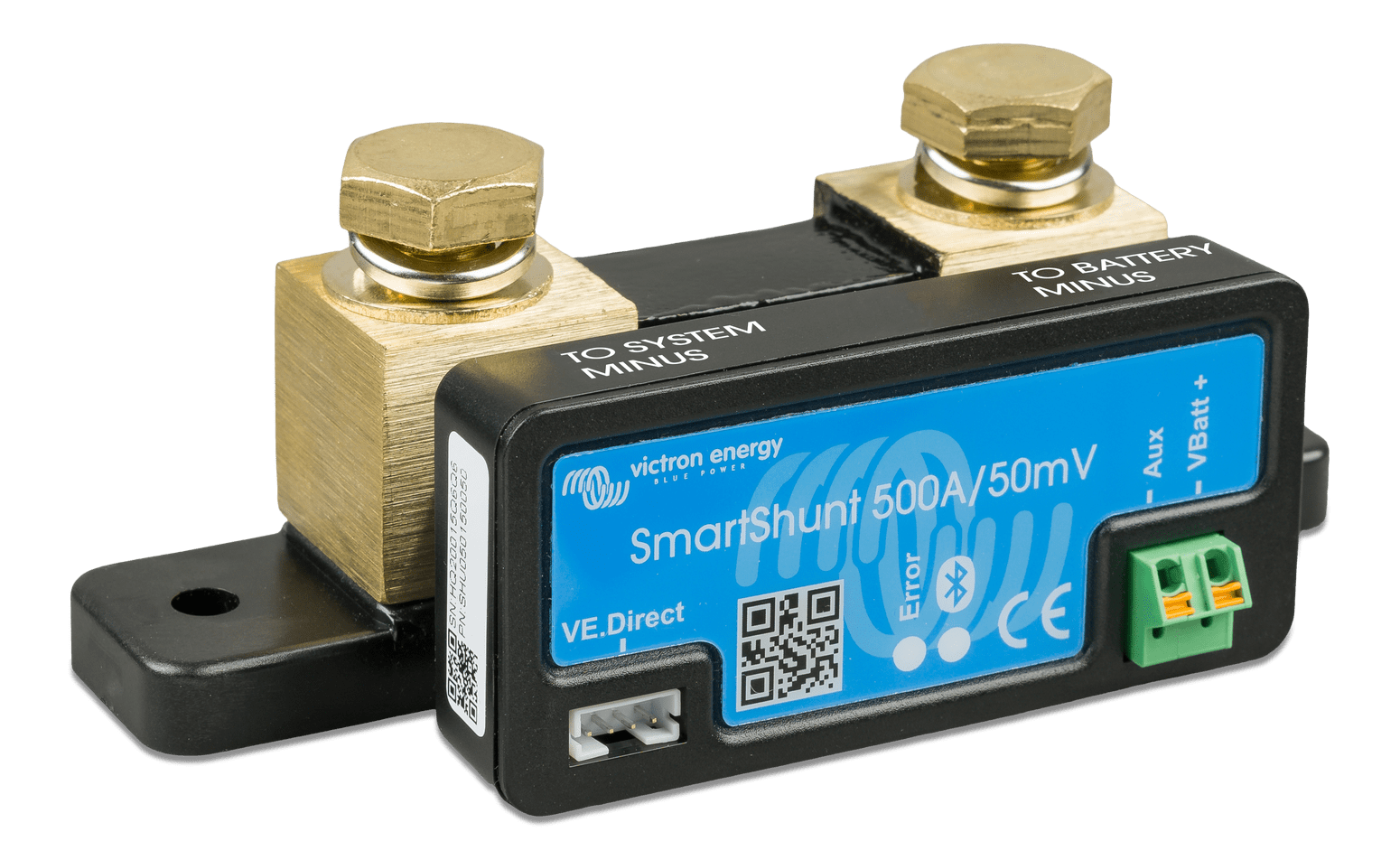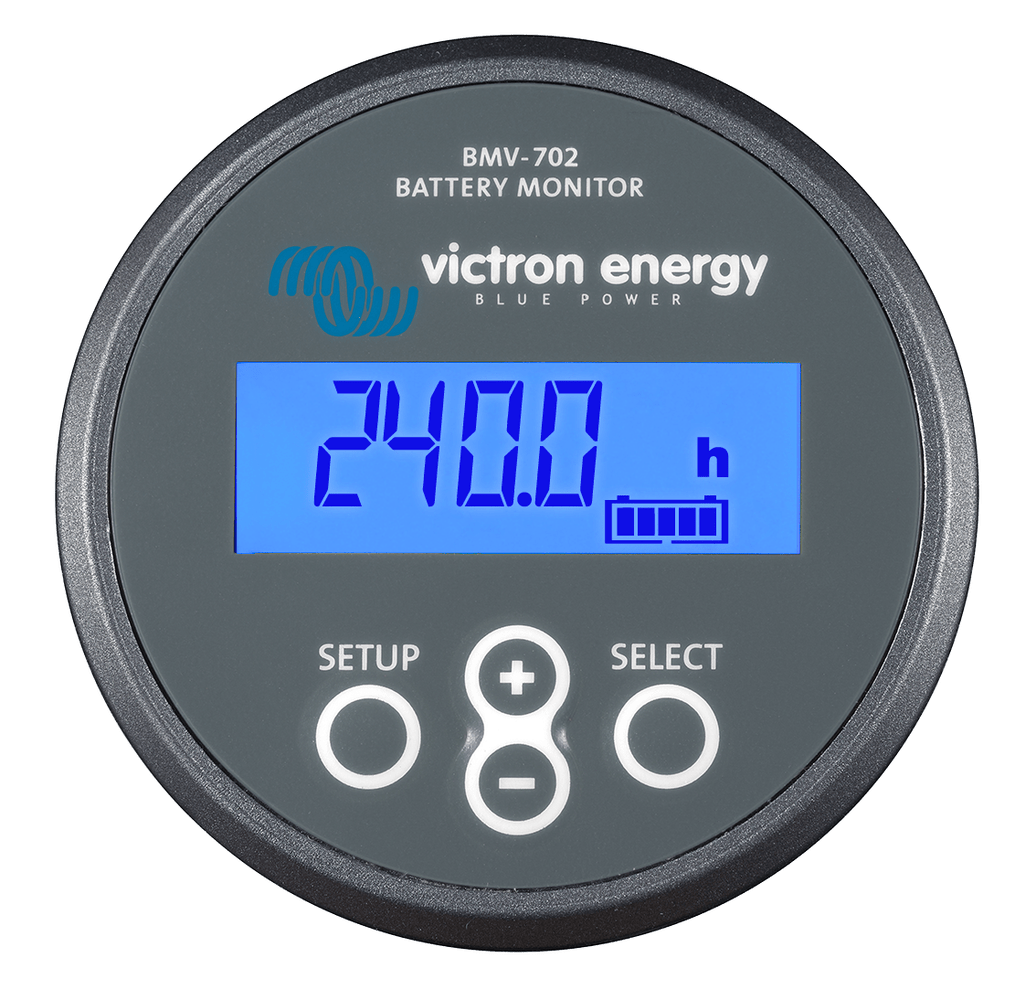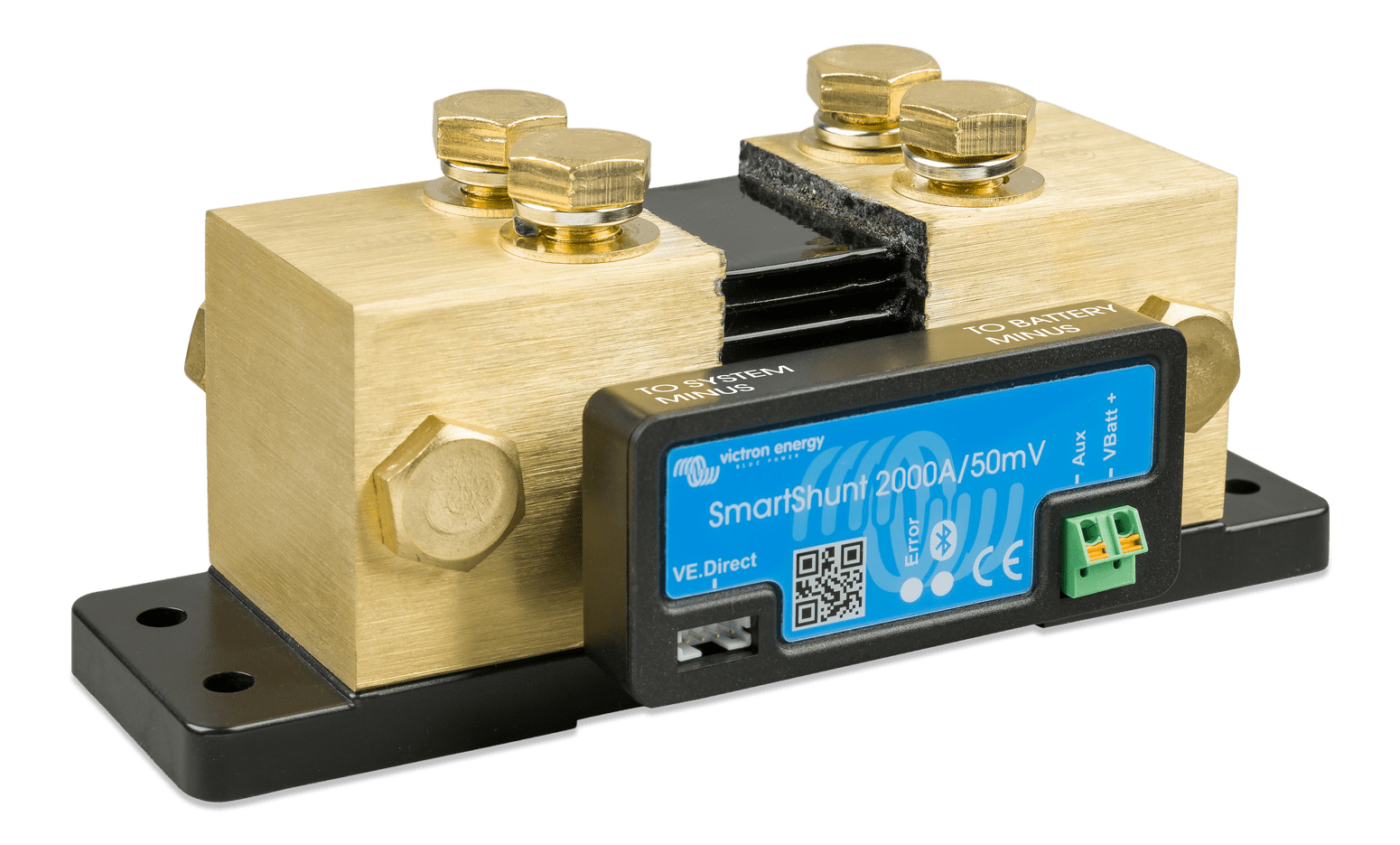Victron SmartShunt: easy install, networked, all-in-one battery monitor

I’ve found Victron’s BMV battery monitors to be simple, reliable, and easy to understand. Now, the new SmartShunt combines the BMV’s shunt and electronics into a single unit barely larger than the regular shunt with Bluetooth and Victron’s VE.Direct networking built-in. In my testing, the SmartShunt works just like a BMV without the gauge portion, while also being much simpler to install. And I don’t miss the little gauge display because there are so many other ways to see and use SmartShunt battery data, suitable to boats large and small (and RVs).
So far, I have not used a BMV or SmartShunt as part of a Victron monitoring network. Neither my boat nor RV has a Victron GX hub like the Cerbo that can collect data from various Victron power products and display it in various ways — including polished MFD pages, show-most-anywhere NMEA 2000 messages, and the free VRM remote monitoring that Ben E. has so praised.
So while I’ve done my SmartShunt testing by connecting directly to its Bluetooth radio in the SmartShunt, and that might be fine for some boats, the Bluetooth may only be used for initial configuration in more advanced installs. I think the SmartShunt can really shine by providing simpler installs on larger, more complex Victron systems. With the VE.Direct port built right in, monitoring multiple battery banks is as simple as inserting the shunt inline in the negative path to the battery, installing the thin battery plus wire, and making the VE.Direct cable connection.
And given the advanced displays possible with Victron networks, there’s really very little use for the small BMV gauge display. In fact, one reason for developing the SmartShunt mentioned by a Victron rep at METS was the number of installs they’d seen where the BMV gauge was dangling somewhere behind a panel.
I’ve used a BMV-702 (like what’s pictured above) aboard Have Another Day for about five years now and it’s served me very well. Since installing the BMV-702 I’ve thought its weakest link is the display on the gauge itself. It’s a one-line LCD with a series of 8 segment digits to display all information. My gauge is mounted low and in order to see it I have duck way down and try to get eye-level with it. Fortunately, I haven’t been bothered by this weakness because I also installed the Bluetooth module on my 702. Once I installed the excellent Victron app I quickly realized that would be my primary interface to the battery monitor.
All Victron battery monitors use Coloumb counting to monitor the state-of-charge (SoC) of the connected batteries. Coloumb counting monitors depend on accurate information about the battery bank and periodic full charges to allow the monitor to synchronize their reading with the actual state of charge of the bank.
The SmartShunt is available in 500, 1000, and 2000 amp versions and support battery banks from 6.5 to 70 volts with capacities from 1 to 9,999 amp hours. The 500amp SmartShunt carries a list price of $148, the 1,000 amp SmartShunt lists at $254 and the 2,000 amp unit lists for $347.
Without a built-in display, all interaction with the SmartShunt occurs via Victron’s VictronConnect app. VictronConnect, available for iOS and Android, is an intuitive and straightforward app for monitoring the status of and configuring any Victron Bluetooth enabled equipment. The app automatically detects compatible equipment in range and makes connecting simple. Once connected to the SmartShunt you can see the current status of the shunt as well as lifetime history and trends for the current connection.
The geek in me loves the history tab in the app. It’s full of information about how much power the batteries have provided, how much electricity has gone to charging them, and the average power consumption of my house bank. I find the trends tab a little disappointing. There’s great information provided in the trend view but if the mobile device screen turns off, you change apps, or even rotate the screen the history is dumped from the trend view. That really limits the usefulness of the data for me.
VE.Smart Networking allows the SmartShunt to communicate wirelessly via Bluetooth with other Victron VE.Smart Networking devices. The SmartShunt can share battery information with Victron Bluetooth equipped solar chargers to assist the charger in ensuring batteries are fully charged while not overcharging them.

I’ve installed a SmartShunt on my RV and been using it there for about a month. Once configured the SmartShunt works exactly like a BMV and that’s a good thing in my book. You don’t get battery state of health (SoH) like you do with Balmar’s SG-200 but I’ve found that what you do get is good information, reliably, and simply presented.
As I mentioned, my BMV is located low in an electrical panel on Have Another Day so nearly any time I check my battery status I use the Bluetooth app. So, I’ve barely noticed the lack of display with SmartShunt. But, what I have noticed is that because the Bluetooth radio is located in the shunt right by the batteries rather than in the display head I’m getting much shorter Bluetooth range. If I were using the SmartShunt’s Bluetooth only for configuration that would be a complete non-issue, but because I’m using Bluetooth for monitoring it’s a little more of an issue. In this respect, it’s possible a BMV would be a better fit, but I also plan to add a Cerbo GX at some point and that will likely render this issue moot.
I think the SmartShunt might realize it’s greatest utility when connected to a full VE network but it’s still very useful as a standalone device. It can’t be beat for simplicity and clean installation. I’m wondering if in the future we might see BMVs based on the SmartShunt with the gauge display just connecting to the VE.Direct port, and maybe even one display working with multiple shunts, but that’s just my speculation. Regardless, with a street price around $130 this little device delivers a lot of information and can easily save more than it costs by helping you get the most out of your batteries without abusing them.



















Two important differences to note between the SmartShunt and the BMV712:
1. The SmartShunt has no programmable relay. The BMV has a small relay that can be configured to change state on high/low voltage, SOC set points, manually via VictronConnect App, or even other events in a networked system.
2. The SmartShunt has no visual or audible alarm. The BMV has a piezo alarm and flashing screen backlight that can be configured to alert user of various battery alarm conditions.
If these features are required the BMV display can be installed with a short cable within or near the battery compartment. An inexpensive 2″ gauge mounting bracket can be used to mount the BMV display perpendicular to a bulkhead instead of through it. It can also be helpful to have an eye into how the batteries are doing when working on the electrical system.
Kai,
Thanks for those points. They’re both highly relevant and very good distinctions between the options. The second difference is especially important for standalone use but less so for part of a Victron network.
-Ben S.
The SmartShunt does have the advantage of being slightly more accurate and less susceptible to noise because the analog to digital measurements are happening at the shunt instead of at the end of a long cable like it does with the BMV.
Hi Ben,
This looks good, and probably a great replacement for my two antique Link 10s. Question: can the software sum a pair of these? We have two house banks (plus a start battery, but simple voltage monitoring is fine for that) and I would really like to see the total of the two. It isn’t essential, but it’s something I would see as a significant step up from my current 2-monitor setup.
I agree with you regarding Bluetooth range – I have a “SmartBatterySense” on my #1 House battery, and the range is significantly less than for my solar regulator, which is mounted high up in the Nav station. While I can see the solar regulator anywhere onboard, the battery sensor (which is where a SmartShunt would live if I put one in) is good only in the salon, Nav station and forward end of the cockpit. Maybe they can offer a “remote antenna facility” for the Bluetooth 🙂
Hartley,
I don’t think the software can combine two shunts into a single virtual bank but I have to admit I haven’t tried.
Currently I suspect Victron would tell you the Bluetooth antenna option is to use a BMV-712 instead of a SmartShunt since the BMV-712 has the Bluetooth radio in the gauge instead of in the shunt.
-Ben S.
Yeah, you are probably right – but then I’m back to using all that fiddly wiring from shunt to gauge 🙂 Maybe I can find some sort of “Bluetooth repeater” to assist. Thanks!
Hartley
“Fiddly wiring”? The connection is an ethernet cable with RJ45 connectors.
Hi Charlie,
Yep – “fiddly” – to go from my battery compartment to the inside of the nav station where the gauges would be is a maybe 10′ run, through one 2′ wiring channel, thru three bulkhead holes and would need to be secured all along the way. The connections at the ends is the least of it, especially when you get olde and inflexible like me and laying on the sole reaching into lockers and around corners 🙂
The current wiring for my two antique (but functional) Link 10s is two runs of jake (4-conductor #22 solid) so I wouldn’t even be able to reuse those.
Hartley
I feel your pain. I’m a marine electrician with lots of aches and pains and the flexibility of a 2 x 10.
Illustrating the evolving networked Victron power monitoring that the SmartShunts will work well with, check out the Furuno glass bridge integration announced yesterday:
https://www.victronenergy.com/blog/2020/07/30/new-furuno-navigation-victron-compatibility/
I’m personally a little disappointed because this apparently won’t display on my boat’s TZT2 12, but then again I get this sort of presentation of my Victron GX data on an iPad running Garmin’s ActiveCaptain app (though there’s no Garmin hardware on the boat) and the underlying data is also now on my N2K network (though I’m struggling a little to make it visible and available for alarming).
I personally do not care for BT at all (or proprietary protocols/connections).
What I do want is a battery monitor with build in NMEA 2000, and/or Ethernet/WiFi (so I can monitor batteries from home over the boats Internet router).
Martin, a BMV712 or SmartShunt connected to a Victron GX hub like the Venus or the new Cerbo does put your battery monitoring onto Ethernet and then off boat to their VRM cloud service. And same for Victron inverter/chargers, solar chargers, and other devices networked to the GX hub. The system has been working great for me for well over a year, and in the last several months the GX hubs have gotten pretty complete NMEA 2000 output.
https://panbo.com/victron-cerbo-gx-good-ac-dc-power-monitoring-gets-better/#comment-104623
Martin,
This might be just what you’re looking for: https://panbo.com/veratron-debuts-nmea-2000-intelligent-battery-monitor/. The only concern I have with this is that it assumes you have a battery post available and want to move to a threaded stud, which works in many but not all scenarios. Yacht Devices has also announced a NMEA 2000 battery monitor but it was supposed to ship in early 2020 and hasn’t started shipping yet.
-Ben S.
Another case of my timing be just a bit off. I recently installed a BMV700H on a system for which the new SmartShunt may have been a good choice – if Victron makes it available for hi-voltage systems. I’ve been involved in the rebirth of an 1896 wooden motor launch (via it’s 2018-2020 rebuild) that has an Elco 96v electric drive unit. This is powered by 27Kw of LiIon batteries, and the partnership that owns it needed a way to be able to monitor the SOC remotely for scheduling purposes. We used a BMV700H since the regular BMV kit tops out at 95v, and the battery bank hovers in the 108-116v range. The BMV talks to a Color Control GX head that is tied to a Peplink router for cellular comms to Victron’s VRM, which the groups IT guru (not me) has linked to the ownership web portal. This also provides location data and can have a geofence. All very neat stuff. The round display gauge of the BMV is relatively ancillary to the whole kit, and as Ben mentions is not the most easily read device. But Victron is doing some really neat stuff.
And this Smart Shunt is backordered until mid-October. I don’t know if Victron hits their estimates, but this seems like a core piece of functionality and I have to believe that they’ve just pushed any installs this season into next season.
Hi Keith, yes, its an unfortunate mix of COVID related production issues, and enormous popularity of the new SmartShunt. We’re working extremely hard to have plenty stock again – as you said: products like these should be in stock always.
Is there any guidance for using these (or any other shunts) with blueseas ACR’s? It seems that any reliable monitoring is out of the window if used with ACR’s that combine battery banks based on voltage?
I’m certainly not a source of official guidance but I’ve thought about the same issue — and related ones like batteries with a 1 /2 / both / off switch attached. I’ve concluded that the only way to monitor both batteries effectively is with a separate shunt for each battery. Anything else just won’t work because any of these devices effectively change the size of the battery bank when they’re combined or not combined.
The other option, if you don’t care about the state-of-charge of one of the batteries would be to just monitor voltage on that battery. That might work if one battery is a starting battery and the other a house battery. In that case, you care much more about SoC of the houe battery and monitoring voltage might be enough for the starting battery.
My center console has two batteries, but they’re basically equals with both potentially doing duty as starter or house battery. So, at some point I’ll probably install two battery monitors on it. And hey, that might be a prime application for the Veratron LinkUp IBS I just reviewed. https://panbo.com/veratron-linkup-battery-monitor-innovative-configuration-and-nmea-2000/